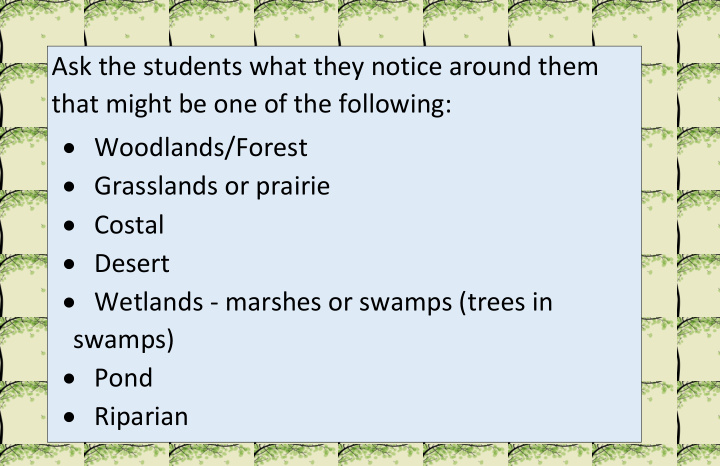



Ask the students what they notice around them that might be one of the following: • Woodlands/Forest • Grasslands or prairie • Costal • Desert • Wetlands - marshes or swamps (trees in swamps) • Pond • Riparian
BIRD HABITAT BRIDGES TO BIRDING
WHY IT IS IMPORTANT TO PROTECT HABITATS Provides for a diverse environment Provides the four essential survival requirements • Food • Shelter • Water • Space
WHY IT IS IMPORTANT TO PROTECT HABITATS
BIODIVERSITY – IT TAKES A VILLAGE • Biological diversity is the complex net that holds our planet together. All the different species living together increases the success of a habitat. • Umbrella species are species selected for making conservation-related decisions. • Providing protected habitats for these species indirectly protect the many other species that make up the whole community of plants and animals. • Here on the refuge the umbrella species are the GCW and the BCV
BIODIVERSITY – IT TAKES A VILLAGE Red-tailed hawk Northern cardinal Bobcat t Blue jay White -tailed deer Red-eared slider Jackrabbit
THEIR SUMMER HOME- THE REFUGE • Golden-cheeked warblers and black-capped vireos travel long distances to reach their summer home here at the refuge. • The refuge provides a safe and secure place for the birds to nest and raise their young. • Maintains the habitat that is best for the birds when they are breeding Prescribed fire helps to recycle nutrients in the soil and helps control invasive species that compete for the resources in the habitat Remove old growth to make room for younger growth that the birds prefer to nest in
THEIR SUMMER HOME- THE REFUGE National Wildlife Refuge System Map Bird Flyway Map
GOLDEN-CHEEKED WARBLER • • Typical nesting habitat is found in tall, dense, mature stands of Ashe juniper (blueberry cedar) mixed with trees such as oaks, ash, and cedar elm. This habitat provides an ideal mix of vegetation for these birds (where) they are often seen foraging. • GCW use the bark of the juniper trees to make their nests.
GOLDEN-CHEEKED WARBLER
BLACK-CAPPED VIREO • The Black-capped Vireo requires a young, semi-open stand of small trees and shrubs, similar to the habitat seen at the Shin Oak Observation Deck, to have a successful nest. • The birds place their nests low in the vegetation, and can usually be found in oaks. Dead oak leaves, cedar bark, and spider webs are the main materials found in the nests of this vireo.
BLACK-CAPPED VIREO
HUMAN INFLUENCE • One problem is that humans tend to cover the ground with cement and asphalt. This disrupts the natural water drainage, HUMAN INFLUENCE which creates areas of high erosion and sometimes flooding. • Erosion removes soil and vegetation from one area and then moves it away to another location. With the loss of vegetation, the birds loose the trees they need for their nests. • When buildings and unnatural structures, like homes, are placed within the habitat used by animals, it reduces the amount of habitat available for animals. This in turn creates competition for space and food.
HUMAN INFLUENCE
HABITAT LOSS ACTIVITY This activity demonstrates what happens when the available habitat that the birds use is removed due to human influences. 1. Place hula hoops on the ground. 2. Have one student stand in each hula hoop representing a GCW and its territory. 3. Presenter takes away a hula hoop and states what type of human influence is happening. Examples: a new subdivision, a shopping center, a school, a new ball field etc. 4. Continue until all the GCW are in one hula hoop. 5. Discuss how this affects the four essential requirements for life, water, food, shelter and space.
HABITAT LOSS ACTIVITY
Recommend
More recommend